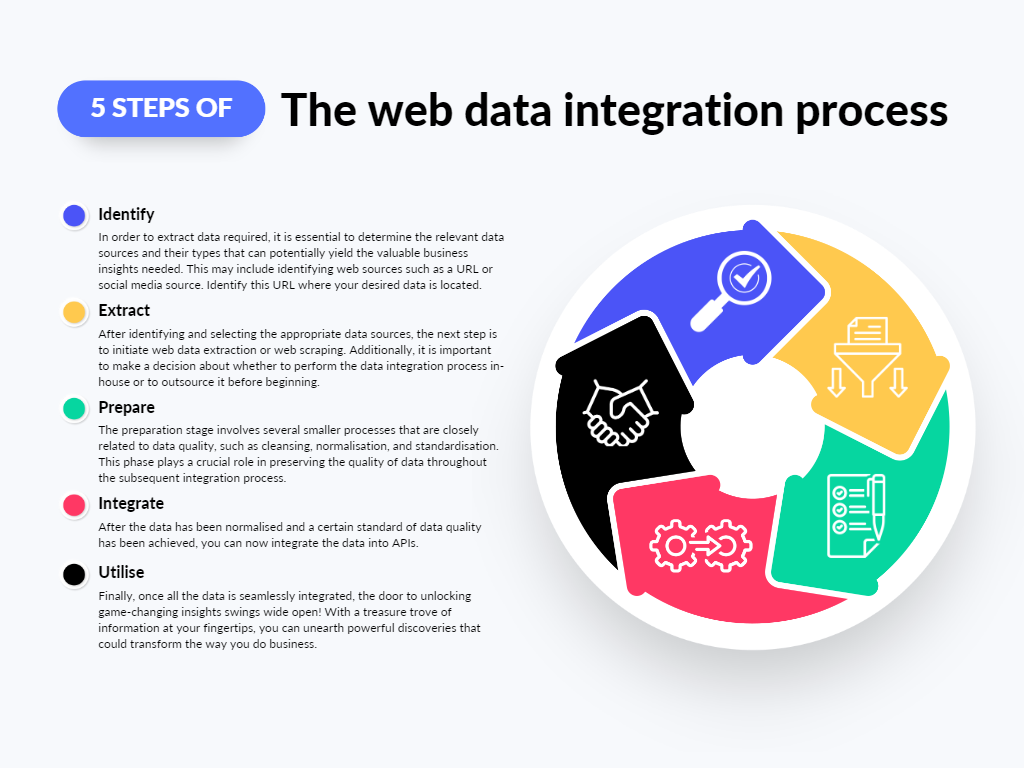B2B web data integration for Australian companies
Are you tired of struggling to make sense of the massive amounts of B2B data available on the web? Have you ever wished for a solution that could seamlessly integrate and transform data from multiple sources into one cohesive workflow? If so, then web data integration (WDI) might just be the answer you’re looking for.
Now, we know what you’re thinking – “Web integration? That sounds like a snooze fest!” But trust me, WDI is more than just your average web scraping tool. It’s a powerful process that can unlock hidden insights and provide invaluable information to businesses and analysts alike.
With the data explosion showing no signs of slowing down (175 zettabytes by 2025!), understanding the data lifecycle has become increasingly important. And that’s where WDI comes in – it’s a sophisticated solution that includes everything from data extraction to standardisation, API integration, and data mapping.
But don’t just take my word for it – many Australian businesses have already turned to WDI for its benefits in improving data quality and maximising the potential of web data. And with 2.5 quintillion data points created daily across the world, experts know that traditional methods like web scraping can only take us so far.
A world beyond web scraping
Before we dive into the world of web data integration, let’s take a moment to explore the foundation of this revolutionary process: web scraping. You see, web scraping (or web data extraction, if you want to get technical) is all about using software to access and extract data from web pages using the Hypertext Transfer Protocol, or HTTP for short.
For those of you not in the know, HTTP is an application-layer protocol that’s responsible for transmitting hypermedia documents – like HTML – and displaying them as web pages for all us end-users to enjoy.
But here’s the thing: while web pages might contain a wealth of information in text form, that data isn’t always easily accessible in its original format. That’s where web scraping comes in – by utilising software to extract data from web pages, we can unlock insights and find success upon analysis.
But web scraping is just the beginning. Enter web data integration – the process that takes web scraping to the next level by amplifying its objectives to include data cleansing, normalisation, performing calculations, unlocking hidden data, custom reporting, and integration capabilities. Talk about a power-up!
And the best part? Web data integration combines all of these objectives into one interactive process with five major steps.

Identify
In order to extract data required, it is essential to determine the relevant data sources and their types that can potentially yield the valuable business insights needed. This may include identifying web sources such as a URL or social media source. Identify this URL where your desired data is located.
Extract
After identifying and selecting the appropriate data sources, the next step is to initiate web data extraction or web scraping. Additionally, it is important to make a decision about whether to perform the data integration process in-house or to outsource it before beginning.
The KnowFirst™ API can help you boost your business with reliable data you can actually use. Find out more…
Prepare
The preparation stage involves several smaller processes that are closely related to data quality, such as cleansing, normalisation, and standardisation. This phase plays a crucial role in preserving the quality of data throughout the subsequent integration process.
Integrate
After the data has been normalised and a certain standard of data quality has been achieved, you can now integrate the data into APIs.
Utilise
Finally, once all the data is seamlessly integrated, the door to unlocking game-changing insights swings wide open! With a treasure trove of information at your fingertips, you can unearth powerful discoveries that could transform the way you do business. For instance, you could harness the power of machine learning and other cutting-edge AI processes to uncover novel insights from your integrated data.
The easier option
Want to skip these steps? We have done the hard work for you. Check out our API options. By integrating our powerful API into your applications, you can search, filter and retrieve relevant data records to enrich your existing data, and gain a competitive edge in the market.
With more than 3M+ company profiles from the largest professional network, you can access data such as:
- Contact information
- Locations
- Social media profiles
- Contracts and tenders
- Company financials
With more than 12M+ company profiles from the largest professional network, you can access data such as:
- Current and past employees
- Salaries
- Employee analytics
- Employee reviews
- Contact information
With 238M+ records from the largest professional network, you can access data such as:
- Online reputation
- Social media trends
- Web traffic and rankings
- Google ads
- Tech stacks




